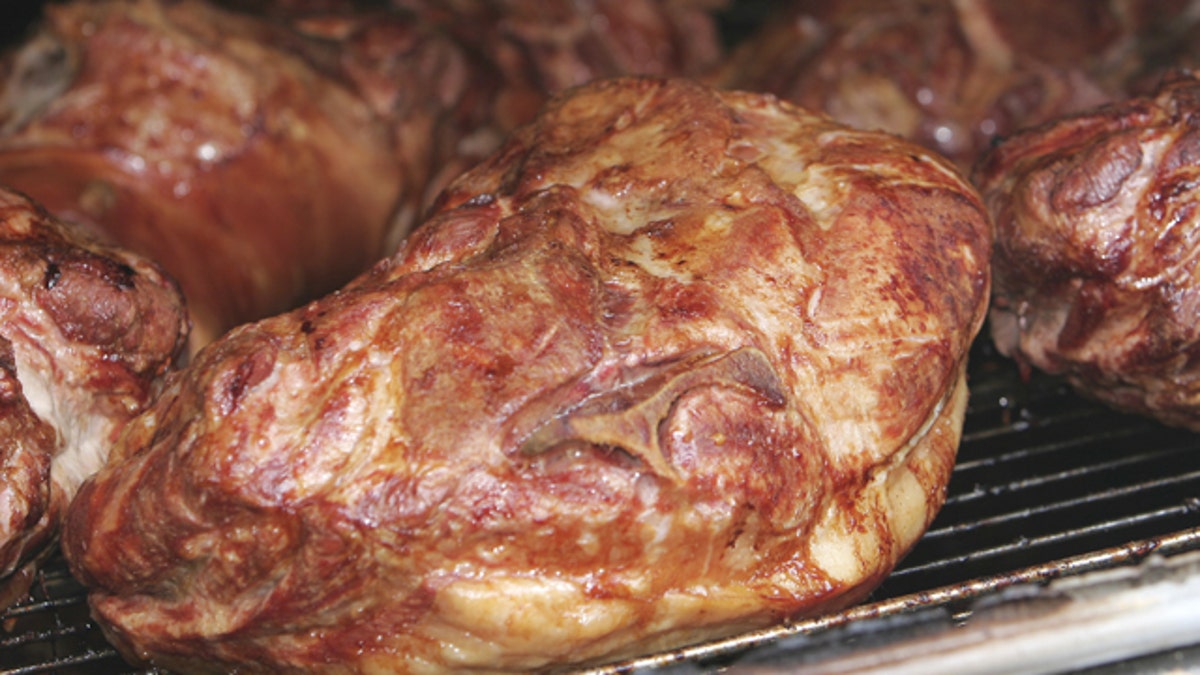
(Hudson's BBQ)
“Some people say that North Carolina is the acknowledged home of BBQ. That’s like saying that Atlanta is the acknowledged home of the waffle because it had the first waffle restaurant in 1955. It’s a logical connection that just cannot be made.”
So says Lake E. High, Jr., president of the South Carolina Barbecue Association, whose knowledge of Southern culinary history equals his passion for barbecue. Barbecue, he declares, originated in South Carolina. Spanish colonists who followed the first wave of Conquistadors brought pigs to South Carolina: “Conquistadors didn’t bring pigs because they weren’t settling.” Local Indians taught the Spaniards how to slowly cook whole hogs over low, indirect heat; “the first authentic barbecue was served in South Carolina back in the 1500s.” High makes it sound like a first-person account.
His second point: “Barbecue” should be used primarily as a noun and that noun refers only to pork. He helpfully explains how to use it as a transitive verb and simultaneously messes with Texas: “One can ‘barbecue’ beef, and do it deliciously, but the final product is not ‘barbecue.’ It’s barbecued beef.” Yankees and Midwesterners, says High, don’t “barbecue” burgers and brats. They “grill” them. “And the thing they’re cooking them on is properly called a grill, not a barbecue.”
Jimmy Stevenson of Doc’s Barbecue & Southern Buffet in Columbia agrees. “Growing up we dug pits in the ground, used hickory and oak coals, and cooked whole hogs,” says Stevenson. While it’s now more common to do pig parts rather than the whole hog, his customers still order a fair amount of “pig pickin’s.” That’s because, Stevenson points out, the South’s culinary customs are as much about food as they are about the region’s long-held and storied traditions. Cook skin-side up for about ten hours, he says. The fat beneath the skin melts, seeping through the meat, moistening and flavoring. You flip it and cook for a few more hours. It’s much harder to do well than it sounds.
Given South Carolinians’ love/obsession with barbecue, and the fact that they’ve been ‘cueing for about five hundred years, it makes sense that that state would have/boast more than one sauce. In addition to the whole-hog-melting-fat-indirect-heat thing, what truly makes South Carolina’s barbecue one-of-a-kind is that it’s the only state in the country with four distinct barbecue-finishing sauces. Those are sauces that are served with barbecue or painted on when the meat’s nearly done (as opposed to basting sauces which keep the meat juicy during cooking.) They are in historical order: vinegar and pepper, mustard, light tomato and heavy tomato.
Vinegar and Pepper is found along the coastal third of the state, and was brought over by the Scottish families that settled there.
Mustard is the state’s most iconic sauce and is popular throughout the middle third of the state. It originated with a mid-1700s wave of German immigrants who arrived with their favorite condiment. It’s usually mustard mixed with ketchup and spices.
Light Tomato, from the northwestern corner along the border of North Carolina and Georgia is a thin vinegar and pepper sauce mixed with a little ketchup, was popularized when ketchup became mass-produced.
Heavy Tomato, falls along the lower third of the state that borders Georgia. It’s thick and sweet and is what most people think of as barbecue sauce.
All of these let you tailor your pork to suit your own flavor profile. While vinegar and pepper is also found in North Carolina and heavy tomato in Georgia, South Carolina is the only place you’ll find mustard. As to which of the four South Carolinians prefer, “it’s obvious,” says Stevenson. “It’s whatever you grew up with.”
South Carolina is a lot like a private club, he says, which is why it’s nearly impossible for outsiders to comprehend it, much less understand why it has four sauces. That they never settled on just one sauce may be due to a strong sense of regional identity and honoring traditions. Or, says High, it may be due to the fact that South Carolina’s “too large to be an insane asylum, too small to be its own country.”
----------
Doc’s Mustard Sauce
Courtesy: Doc’s BBQ & Southern Buffet, Columbia, SC
Ingredients:
3 1/2 cups yellow mustard
3 tbl. plus 1 tsp. white vinegar
1 tsp. burgundy
5 oz. brown sugar
2 1/2 cups ketchup
1/3 cup honey
1cup corn Syrup
Pinch of Red Pepper
1tsp. coarse black pepper
2tsp. lemon juice
1. Place all ingredients, except honey and corn syrup, in the mixing bowl and mix thoroughly.
2. Add corn syrup and honey and mix again.
Yield: One-half gallon
Doc’s Pepper Vinegar Sauce
Ingredients:
6 cups white vinegar
1 1/2 cups ketchup
1 1/2 cups apple juice
2 tbs. Texas Pete
3/4 cup brown sugar
1 1/2 tbl. salt
1tbl. crushed red pepper
1tbl. fine ground black pepper
Mix all ingredients well. Best if left to marinate over night before use.
Yield: 1/2 gallon
